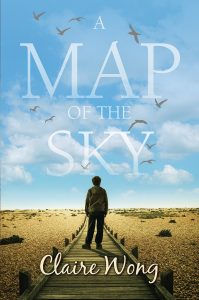Locations Can Be Characters Too
 I treat the settings for my books as if they were people. If that sounds a bit mad, stay with me and I’ll try to explain.
I treat the settings for my books as if they were people. If that sounds a bit mad, stay with me and I’ll try to explain.
What are your favourite childhood memories? Pretty much all of mine take place outdoors. Whether it’s blackberry picking with my mum and sister (returning home with telltale purple hands and face from eating most of the harvest) or pretending to be polar explorers by trekking to the end of our snow-covered garden to plant a flag next to the swing, I have always loved being outside. I grew up learning the names of constellations and birds of prey, spent summer holidays looking out for dolphins off the coast, and I would not change that for anything.
I believe it does us good to get out of our houses and offices where we can remember there’s a whole world made up of trees and birdsong and sunrises. In times of heightened stress, one of my favourite antidotes is to go walking through whatever bit of countryside is most readily available. At university, it was the riverside meadow where horses have grazed since ancient times. These days, it’s the woodland path that turns fiery gold with each successive September.
So it makes sense that this would feature strongly in my novels. It’s hard not to write about the things that make us feel most alive.
In The Runaway, I wanted Dyrys Wood to be more than just a backdrop to the story. The forest is very much a living thing, looking on throughout the main character’s journey. You can tell a lot about a person by how they respond to their environment, and so the forest location gave insights into the character arcs I was writing. At times she saw it very much as an ally, providing food and shelter, while at others it seemed painfully indifferent to her experiences of the cold, the rain, and the isolation.
My new book, A Map of the Sky, explores further this idea of place having character. Here, the setting is the rugged North Yorkshire coastline, where the characters set out to create a map that goes deeper than telling you place names and roads from A to B. They record childhood adventures, the gifts that the landscape throws out at you as the seasons change. As Beth explains to Kit, the eleven year old protagonist: “It’s about the changing moods of the land, the places where storms are at their angriest over the sea, where the kittiwakes come and nest each spring, or where you’re far enough from the glow of town lights to stargaze. It’s about the sky and all its different complexions, layered over the sea and the land.”
It was a joy to explore and research for this book. One day in June I boarded a train from Leeds to Scarborough in search of my new setting. I walked windswept sections of the Cleveland Way, bought chips on the seafront (it seemed wrong not to!) and climbed up onto the castle wall that looks out across the North Sea. For me, it’s not enough just to look up a place online, though we are lucky these days to have such tools available for research. But I needed to know what the air smells like, see what plants are growing beside the path, and get a feel for how the light falls on the water at a particular time of day.
Perhaps I’ve misled you a bit here. Given how I’ve gone on about my love of the outdoors, you might be picturing someone athletic and intrepid, weatherbeaten and fearless. That’s not me. I’m not sporty or good with heights (which makes my efforts at mountain climbing all the more challenging). In that regard perhaps I’m most like my character Maddie, who in A Map of the Sky gives up her job as a teacher to walk a pilgrimage from Norfolk to Whitby Abbey. She knows she doesn’t look the part, and that people will ask questions, but something drives her to go after adventure. I wanted to show ordinary people engaging with the natural world, enjoying those moments of awe we get when we see the beauty and drama of the landscape.
So what about treating the location as a person? In A Map of the Sky, it’s the North Sea that takes on this role. Maddie calls it ‘the constant, silent companion on your travels’. Its mood changes depending on the weather, so that it can be bright and beautiful, bleak and brooding, or fierce and stormy. And in turn, its vast presence is what teaches the characters more about themselves.
A strong sense of place in a novel can transport you out of your surroundings and into the world of its pages. And isn’t that one of the joys of reading, to feel as if you have stepped into another place or time completely?
—
 Kit doesn’t understand why his family has been uprooted to a remote coastal village in the North. Why did they leave so suddenly, and why has his Dad not joined them? At Askfeld Farm Guesthouse he meets an eclectic group of new neighbours and forms an unlikely friendship with Beth, who suffers from a chronic illness he does not understand. Kit learns that Beth, who cannot leave the guesthouse, is trying to draw a map from memory that shows all her favourite childhood haunts.
Kit doesn’t understand why his family has been uprooted to a remote coastal village in the North. Why did they leave so suddenly, and why has his Dad not joined them? At Askfeld Farm Guesthouse he meets an eclectic group of new neighbours and forms an unlikely friendship with Beth, who suffers from a chronic illness he does not understand. Kit learns that Beth, who cannot leave the guesthouse, is trying to draw a map from memory that shows all her favourite childhood haunts.Category: Contemporary Women Writers, How To and Tips
Comments (4)
Trackback URL | Comments RSS Feed
Sites That Link to this Post
- 077 :: Cat In A Box | T.H.E.J.A.Y.M.O | May 13, 2019

























I simply adore the concept of treating place as a person! I can see how it would bring so much more into a story. Thank you for sharing this.
Excellent.
I am sure we should be spending more time in the open air and in touch with the seasons.
Places are characters in other media too…..Oxford’s place in Morse or Glasgow in Taggart for example.
What a great piece, Claire. I could not agree with you more. The books I enjoy reading most are ones with a strong sense of place and a strong element of nature woven into the story.
In my own writing, nature is a key theme. My recent novel, Peculiar Savage Beauty, takes place during the 1930s in the Dust Bowl – that setting most definitely takes on a life of its own in the story, along with the more traditional characters.
Thanks for sharing your insights!